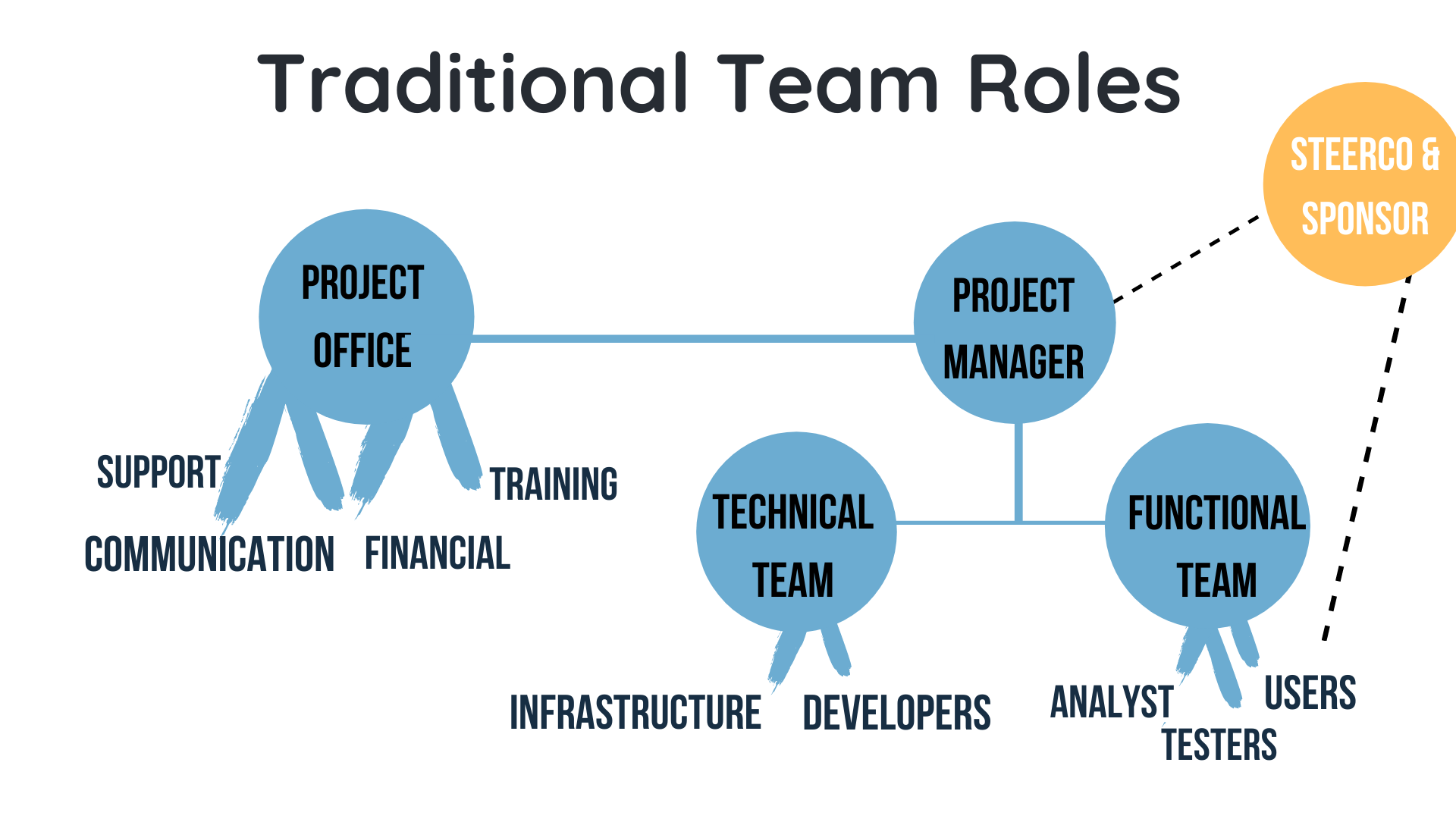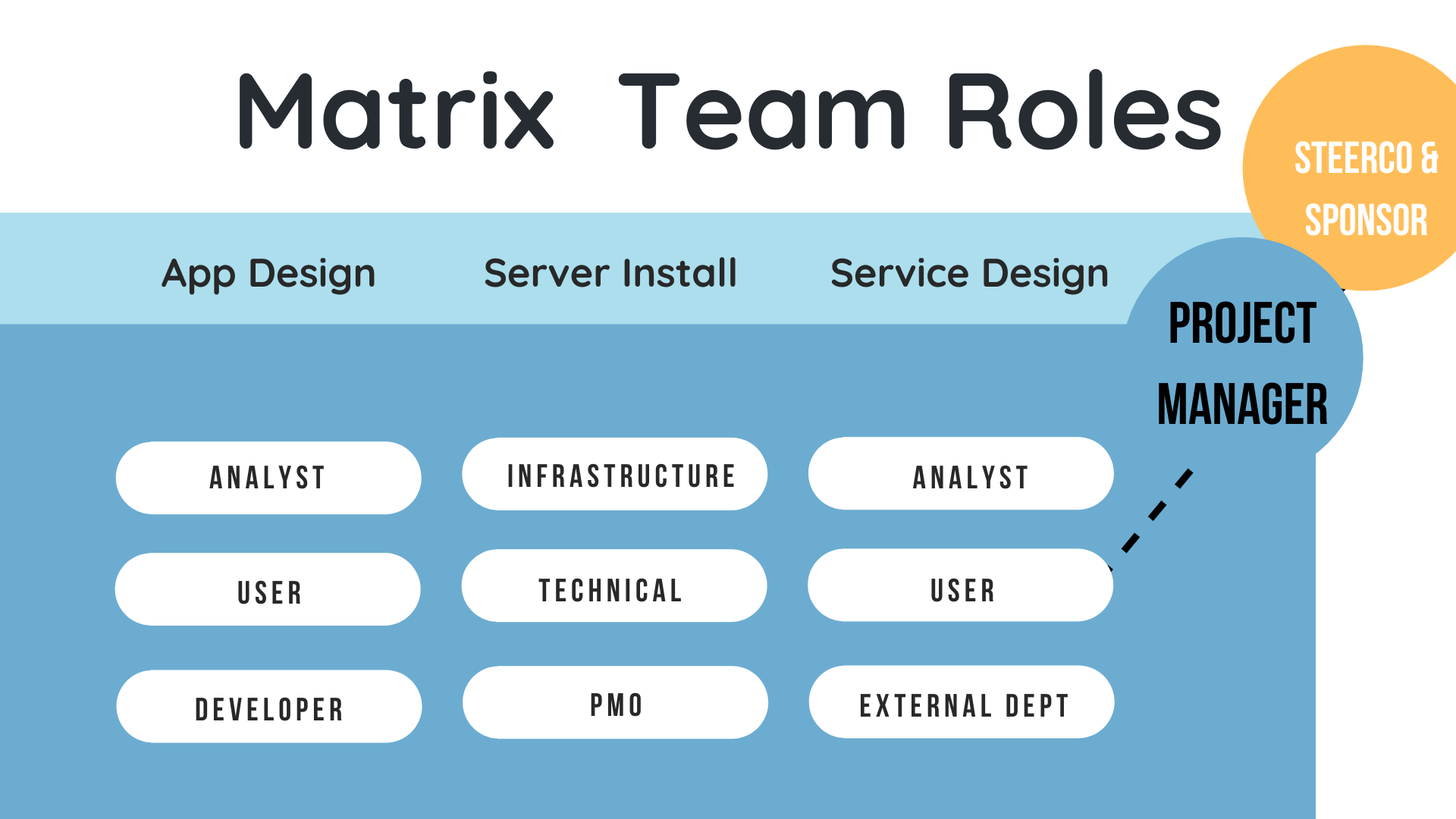Team Roles: The Right Stuff every project needs
What is the Right Stuff?
Having the Right Person in the Right Place at the Right Time is a skill every Project Manager needs to master and every project needs.
But what Roles and Responsibilities does a Team need?
Getting the team roles right can create a dynamic, high-performing team culture. And, working in a high-performing team should be the goal of every Project Manager and team.
Team roles differ based on your project goals, solution, and approach. The Project size and number of staff required also will dictate the types and numbers of team roles. If the Project is simple and smaller, some roles may be consolidated. Larger projects may have more roles or more team members within a role.
These variables impact the team roles, skills, styles mix on every Project. Let's break down the two most common Team Structures and discuss how they impact the Team Roles and Responsibilities.
The Agile Scrum Project Framework is a newer approach and has significant differences to the roles below. Agile Roles will be covered in a future post.
The General Team Role Framework
Teams are use within projects to design, create and deliver a result to an organization. Teams are generally role and skill diverse to ensure all aspect of a project deliver success to the end result.
Sub-Teams are used on larger projects to define tasks into smaller working groups with specific skills. Sub-teams often have their own team meetings, working sessions, and progress reporting.
Sub-team reports are consolidated into the PMO’s Project reporting to the Project Manager, Sponsor, and Steering Committee. These sub-teams roles, responsibilities, and skills focus on a single aspect of the work to allow for more effective and efficient effort. Sub-teams generally have:
Role specialization with their subgroups and
Report to a Lead of the sub-team
Focus on an specific set of task types
“Alone, we can do so little; together we can do so much.”
Team Roles and Responsibilities - Skill Set driven
A Traditional team is a hierarchical top-down team run to maximize results on large and complex projects. These include projects with government oversight, regulatory requirements, and high capital investments where documentation milestones and process rigor is needed.
The Project Outcome is owned by the Project Sponsor. The Team is Led by the Project Manager.
The Sponsor's role is to act as the overall customer of the Project. They are responsible for:
Ensuring the Project meets the needs of the organization
The target user group's requirements are met, and the solution is adopted
The Project Business Case Return on Investment (ROI) is realized
The Project budget, solution, time requirements are within agreed metrics
The Project outcome is compliant with policies and regulation
The Sponsor is a member of the steering committee and reports to senior management.
The Project Manager is the leader of the Project and oversees the execution of a project. They are responsible for:
Managing project scope and deliverables, compliance with internal project processes
Certifying adherence to staff management protocols
Overseeing overall project scope, timelines, and budgets
Ensuring the solution quality meet agreed expectations
Managing direct reports and coaching as needed
Assuring Compliance related to regulatory requirements
Confirming project activities are executed correctly
The Project Manager reports to the Project Sponsor and the Steering Committee. And, if the Project Manager is an external contractor, they also have reporting lines to their own organization.
See "The 7 Essential Leadership Skills" for more on the key skills needed for any Project Manager.
If you have questions about why and when Coaching versus Mentoring can help your team, go to my latest post on this topic.
The Project Management Office (PMO) is a project sub-team. The members of this team handle various cross Project functions
Project Management Office (PMO) Lead is responsible for:
Consolidating cross Project processes
Creating and distributing the Project Plan and staff updates
Coordinating with the other leads to update the Project Plan
Flagging issues in Scope or Timeline to the Project Manager and Sponsor
Preparing special reports as needed for the Project
Managing and Coaching the PMO team
This role reports to the Project Manager.
Communications is responsible for:
Ensuring internal and external Project Communication planning and quality
Creating managing and delivering Communication content for the Project
Using the organization's communication protocols
Controlling external communication from the Project Team
Managing the Communication Project planning
This role reports to the PMO Lead. But may also report plans, progress, and results to the Project Manager and Project Sponsor. They may also report to the organization's communications group, external to the Project.
Financial reporting is responsible for:
Managing the budget and cost actuals for the Project
Calculating the cost and cost variances
Addressing accounting issues
Flagging Project under or overruns
Creating the Financial DashBoard to the Project Manager and Sponsor
This role often reports directly to the Project Manager and Sponsor. And may have Financial group reporting lines outside of the Project.
Training is responsible for:
Designing, Creating, and delivering team training
Onboarding team members with training for the Project and their role
Ensuring that all team members have the training needed to execute their jobs
Designing and creating End-User Training
Running the Train-the-trainer event for user learning sessions
This role reports to the PMO Lead.
Project Support is responsible for:
Maintaining project documents, including version control change requests
Creating Project Internal process revisions
Managing on and off-boarding staffing processes, such as badges, desk allocation, and time reporting
This role reports to the PMO Lead.
The Functional Team is a project sub-team. The team's members work with Users to define requirements and focus on the user experience (how the solution works for the solutions user’s).
The Functional Team Lead is responsible for:
Leading the solution design.
Working closely with Users to define an operational process, product, or service, depending on the project goal.
Coordinating the functional needs with the technical build team
Ensuring the design is fit for the overall solution
Managing and Coaching their team members.
This role reports to the Project Manager.
The Business Analyst is responsible for:
Defining the User Experience or solution functionality
Designing the Solution Configuration or solution elements
Documenting the Data Management or information elements
Confirming to, or updating the Processes and Policies of the organization
Defining the technical build requirements
This team may have sub-specialization for each area above or for areas such as system reporting, system processing, and system throughputs. This role reports to the Functional Team Lead.
The Solution User is responsible for:
Defining the their requirements
Designing the solution to meet organizational goals
Confirming build through testing and documenting findings
This team is often ‘on loan’ from the organization and has a dotted line reporting relationship to the Project Manager or Sponsor.
The Testing Team is responsible for:
Designing and building test plans and scripts
Executing functional testing of the solution
Reporting on test results and accepting build components
This group may include business analysts and solution end-users. This role reports to the Functional Team Lead. Users may formally or informally report to the Project Sponsor.
The Technical Team is a project sub-team. The team's members work with the Functional team to define business requirements into technical specifications. They also support any technology that the Project or solution requires to work.
The Technical Team Lead. is responsible for:
Leading the Technical solution design
Working closely with the organization's technical team to align technology backbone and internal requirements
Coordinating with the Functional Team lead
Ensuring the technical design fits the overall solution
Defining, installing, and maintaining the required infrastructure to support the solution
Managing and Coaching their team members
This role reports to the Project Manager.
The Build Team or Development is responsible for:
Designing, building, and managing the technical solution
Creating, running and results reporting for Technical testing of the solution
Working with the Functional Team to confirm solution configuration, functional design specifications
Working with users to test the data migration, as needed
Solution testing the end-to-end product
Planning the cutover go-live to the new solution
Decommissioning of replaced technology, as needed
This role reports to the Technical Team Lead.
The Infrastructure Team is responsible for:
Designing, installing and maintaining the technology backbone: hardware, software, and connectivity are supported
Ensuring all integration points work across the end-to-end solution
Documenting the detailed infrasture map
Planning and communicating the maintenance support scheduled
The Infrastructure team works closely with the Build team to ensure the technology can meet the needs of the Project and is performing to specifications. This role reports to the Technical Team Lead.
“If everyone is moving forward together, then success takes care of itself.”
Team Roles and Responsibilities - Cross Functionally driven
A variation on the traditional team is the Matrix or Cross Functional team.
The Project Roles are essentially the same as above. However, the working groups are defined not by role, or sub-team but by sub-Project teams. Serving as a cross-functional team has many benefits:
a diverse perspective on solutioning.
ability to focus on one specific outcome
long-term working teams build rapport
Sub-Projects make sense where the Project has multiple components running in parallel.
A Project with independent task tracks can be managed in cross-functional teams until the moment of integration. This can be an effective way to manage a project where the teams are:
Designing a business process, and
Building a related technology solution, and
Creating a Service Center to support the service post-go-live
However, even within Sub-Project teams the functional areas need to maintain a consolidated way of working and work approach for consistency in work products.
Some may say this has multiple 'track’ project is actual a Program. That may be true, however, not all organizations make this distinction. And on occasion, a Project morphs into a Program as part of their maturity process. During this transitional period, cross-functional teams with the Project can work while a new organization is put together for the Program.
Either way, these sub-Project tracks are planned with separate tasks and deliverables, aligned and integrated through the work informally day-to-day. And more formally integrated at project milestones. In this case, the sub-Projects, not teams, hold working sessions, team meetings and produce status reports. Sub-teams often have team leads and may work using an Agile/Scrum approach. This works even if the rest of the Project uses waterfall or a Work Breakdown Structure (WBS) approach.
Beyond Roles and Responsibilities
Teams need more than roles and responsibility clarity. They need trust, respect, a shared way of working and complimentary skills. Get more insights into Team Skills and Working Styles with the links below:
What did you think? Are these traditional team roles ones you recognize from your Projects? Did you take another approach? Please share with the community in the comments below. Thanks!










